Olympic travel tips: a guide to recognizing your transit staff
Olympic travel tips: a guide to recognizing your transit staff
For those who might be in our region for the first time during the Olympics, here’s a short series of tips to help you get on your way. (If you do know this stuff already, please pass it along to those who might find this useful!)
So far in the Olympic tips series: info on tickets, bike info, Park and Rides, a guide to transit staff, where to find real-time transit info online, and transit etiquette. Let me know if I should add anymore!
Here’s a short guide to recognizing our transit staff, just in case you need help when you’re out on the system.
We have a number of different transit services—buses, SkyTrain, SeaBus, West Coast Express—and staff for each service have different jobs and uniforms. Hopefully this guide will help you find a transit staff member, plus show you a little about what they do.
SkyTrain Attendants (STAs) and Canada Line Attendants (CLAs)
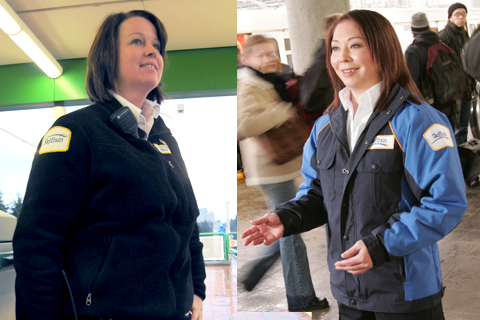
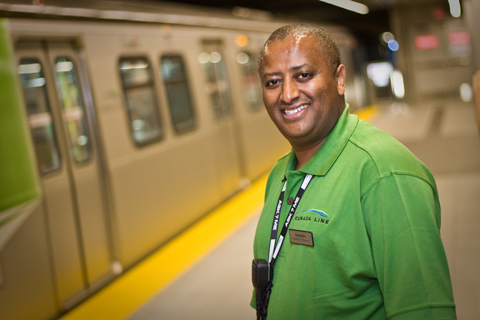
You’ll probably see STAs and CLAs more than any other customer service representative. They sometimes ride the trains, but generally work at SkyTrain stations, helping passengers with information, medical aid, and so on.
STAs can be found on the Expo and Millennium Lines, and CLAs on the Canada Line, which is operated by a separate company under contract to TransLink. Both are a first point of contact in dealing with station alarms and incidents, and will call in resources as needed.
STAs and CLAs may check fares, but do not enforce rules and regulations. They are not police or security guards. They may request compliance with rules and regulations, but they have no powers of arrest or enforcement. For that, they’ll call police.
Both STAs and CLAs are also trained to drive the trains, so if there is a train fault or failure, they’re the ones who determine what the cause of the problem is, and eventually drive the train manually or re-set the computer system as needed. In heavy snows, you may find an STA sitting in the driver’s seat at the front of the train, monitoring the track and preparing to override the automatic emergency brake system, in case a snowfall or blown branch lands in the guideway.
STAs, CLAs and Transit Police officers (see below) can also assist people whose first language is not English, thanks to the Provincial Government Translation Service. This service provides interpreters in up to 150 different languages, so if a visitor needs information in his or her own language, they can contact an STA or CLA, who can put them in touch with the service. CLAs will also wear name tags, indicating what additional languages they speak (if any) besides English.
Olympic Transit Hosts
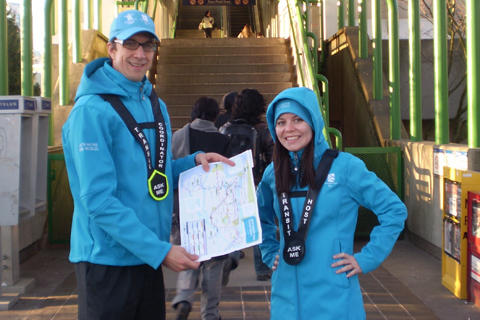
During the Winter Games, staff from TransLink and its family of companies will step away from their desks and help welcome the world. They will be wearing blue jackets and can be found at key stations and transit exchanges throughout the region for the Olympic period. They carry maps and other information, plus a knowledge of the region and its transportation network.
Transit Police
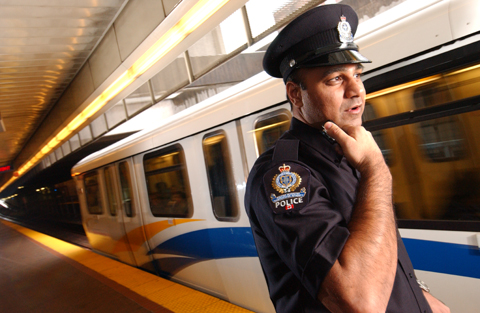
The South Coast British Columbia Transportation Authority Police Service (Transit Police) is a fully constituted police force, and the only transit police force in Canada.
Like any police officers, Transit Police carry guns and other law enforcement tools of the trade. They have full powers of enforcement and arrest both on and off the transit system, which means they can respond to crime situations away from stations.
Their jobs involve checking fares and issuing violation tickets if necessary, and in the course of this, they have captured people wanted for other, much more serious offences: people wanted on federal warrants, and so forth.
Often, Transit Police are called on to assist local police forces with arrests and investigations, securing a scene or backing up the local force. They have the authority to ask for identification: failing to produce identification may result in a charge of obstruction.
Transit Security
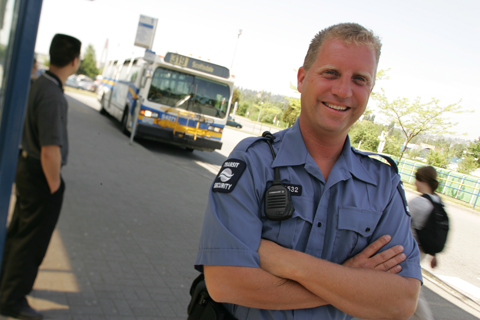
Transit Security officers provide private corporate security for TransLink and its subsidiaries. They can be found throughout the system, particularly at transit exchanges and on the buses.
These officers have powers to arrest without warrant anyone they observe committing a criminal offence on or in relation to TransLink property. They can also inform and enforce Transit Safety Regulations. They cannot write or issue violation tickets and are not Special Constables or police officers.
Marine Attendants
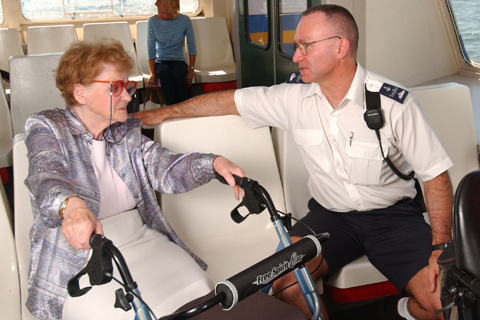
Marine Attendants serve a number of functions on SeaBus. At the terminals, they provide general information to customers on routes and schedules and how to use the Ticket Vending Machines. They are not security officers, but work with them (see below) if need be. They are trained in crowd management, for times when passenger loads are particularly heavy.
On the water, Marine Attendants are certified by Transport Canada in a variety of areas, including marine firefighting, rescues and oil spill response. They perform weekly drills, as well as one major exercise each year.
West Coast Express
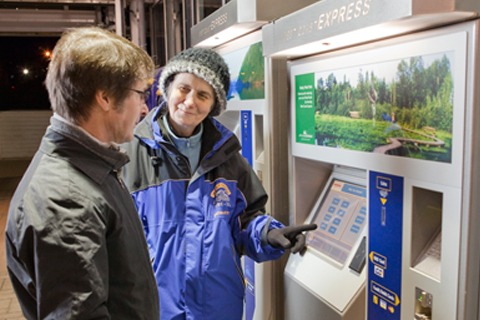
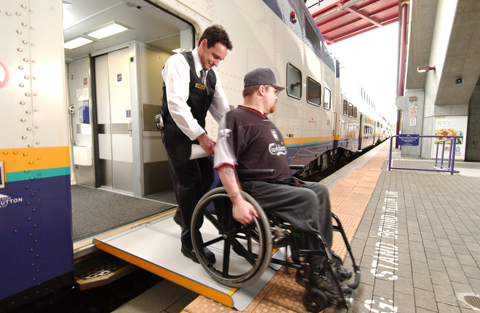
West Coast Express is TransLink’s heavy commuter rail service, running from downtown Vancouver along the Fraser River to Mission, approximately 40 miles (70 km) to the east.
Station Attendants greet customers at stations in the morning and assist in purchasing tickets, provide transit information and generally look out for the safety and security of our riders. If there’s a train delay, they’ll try and suggest other transit options and remain on site until the problem can be resolved.
Conductors are the onboard service staff there to ensure the safe operation of the trains.
They assist with Customer Service where possible and are in contact with WCE Operations as needed.
“Ask Me!” program

To make sure visitors have as many means as possible to get information, TransLink has asked a number of local residents to provide assistance.
We offer the Employer Pass Program, where employees can buy discounted transit passes if 25 or more sign up from the same company. Many members of the program have volunteered to be ad-hoc ambassadors, wearing a red “Ask Me” button to encourage questions from visitors. Feel free to ask them for transit help!






[…] The Buzzer blog » Olympic travel tips: a guide to recognizing your transit staff buzzer.translink.ca/index.php/2010/01/olympic-travel-tips-a-guide-to-recognizing-your-transit-staff – view page – cached For those who might be in our region for the first time during the Olympics, here’s a short series of tips to help you get on your way. (If you do know this stuff already, please pass it along to those who might find this […]
Is there a reason why attendants and police love checking tickets on the Canada Line, and my ticket/pass is rarely ever checked on the Millennium and Expo lines?
Mike: I’m not so sure, but I believe it’s because they want to head off any future fare evasion by vigorously enforcing fares now and driving home the message that fare evasion won’t be tolerated.
This, however, concerns me:
“They have the authority to ask for identification: failing to produce identification may result in a charge of obstruction.”
There is no law that requires me to carry identification. That line above makes it seem like I would be arrested simply for not carrying ID.
Is there a reason why Canada Line attendants don’t honor fastrax stickers?
Like Mike, I too notice the enforcement imbalance. Even more confusing when I’m hearing that “Skytrain” is the same for all three LRT lines.
I don’t mind their presence…. I welcome it as I do feel safer on CLine. Is it because there are more tourists on the CLine? Or it’s a West Side thing?
I thought it was stated in an earlier article that the “SkyTrain” brand encompasses the Canada Line in addition to the Expo and Millennium lines.
Why, then, do “SkyTrain Attendants” not appear on the Canada Line, while the latter wear distinctly different garb? This seems needlessly confusing, particularly for visitors. It also underscores my earlier point about TransLink’s indecision and incoherence in its LRT branding.
I’ve had my ticket checked at Brentwood and Broadway now and again, but not that often. I would welcome an increase on those lines to the level of the Canada Line, although I suspect there might be a staffing/cost issue due to the number of stations.
Is the level of crime on Translink so bad that it justifies police to carry guns? I feel safer for seeing the police but nervous at the same time because there must be a high level of serious crime in order for them to carry weapons. Maybe a North American thing. I am only used to seeing guns in Europe at mainline stations, not on the subway network. Hopefully they can defuse situations without resorting to them.
Most staff are usually very jolly and friendly on the network, especially on the Canada Line. Although, they do tell passengers off for stopping the closing doors when really they aren’t given the opportunity to get off/on due to over crowding in the rush hour. In other words your doors close too quickly! I think this needs to be addressed as I have seen some people hurt by them, they aren’t so gentle as the other lines if they nudge you!
All in all Translink is certainly so much less stressful than other networks to travel on and that is thanks to the staff but also passengers who are generally more relaxed than major cities. Also, traveling on the buses and skytrain you can see some fabulous beach and mountain views which can’t be said for many other cities.
ben K:
Well, ProTrans BC is in charge of the Canada Line staffing and their outfits — TransLink doesn’t have any control over what they wear or how they are branded. So it’s not exactly a matter of neglecting to notice that they are different.
Ohh I noticed the Canada Line is referred to as “SkyTrain” when I hear the annunciator on the 99 B-Line. When the bus nears Cambie, it says “Cambie Street and Broadway SkyTrain Station”… I have a feeling that they just transferred the name from the old Broadway Stn to there.. lol :P
And it doesn’t fit.. so it really bothers me… ahhh!
An addition to my previous post:
I think the way they have the name set up at Cambie would confuse any visitors who have been here before the Canada Line, especially since the annunciator says it is a “SkyTrain station”.
Andrew S:
Well, as ben K alludes to above, Canada Line is considered a part of the SkyTrain system — it’s just one line of the SkyTrain network. Even if visitors have been here pre-Canada Line, they’ll generally know what to expect when they hear “SkyTrain.”
Jhen, could you respond to the concern raised by Cliff regarding identification requests by transit police? That’s something that is a concern for me, too, and I’d appreciate some idea of what would happen in a situation where you aren’t carrying any.
Tessa: I’ve sent it over to the Transit Police for clarification. We’ll hear back soon!
Mike: I asked ProTrans BC (the operator behind the Canada Line) about the fare checking frequency, and the answer they’ve given is “We are just doing our job, which includes fare checking.”
Ric:
Can you tell me a bit more about the FastTrax situation? I am asking ProTrans about it and they are curious for more detail.
Jhenifer, in regards to my fastrax situation here is the problem. When the attendants are doing fare checking there are a lot of them that don’t know what a FastTrax is or how the program works. When I am coming from Vancouver into Richmond they often ask me to purchase an add fare to upgrade my one zone fare card to a two zone. I explain to them that I have a FastTrax and that it is not necessary. They say one of the following: What is a FastTrax and what does it do or the program no longer exists.
Uh? Hello? FastTrax is listed on the Translink website…. http://www.translink.ca/en/Fares-and-Passes/Student-Passes/FastTrax-Pass.aspx
The FastTrax program is over 20 years old. This sounds as bad as drivers telling monthly farecard owners you can’t have 2 adults and 4 children on one trip.
I guess there is a lot of Translink employees driving their cars to college and university in the old days.
I think the frequency of fare checks on the Canada Line is great, I just don’t get why it’s not the same on the other lines.
Re: Identification
I suspect that if you are asked for ID and cannot produce it, they ask you to leave transit property.
At the end of the day, we also rely transit officials (and police, and public safety officals, etc)to use these rules properly. I hope they won’t ask us for ID and kick you out out of spite, but not being able to get someone’s ID on transit property would be a big issue for translink’s public safety officers.
But I suppose i’ll see what jhennifer says…
Thanks for the reminder: I’ll ask Transit Police for an answer again.
I don’t think there is something in law that would permit a police officer to order someone to leave an already public place merely for not carrying ID. There really has to be an antagonizing reason for the ejection.
The only thing I can see that would limit one from being on transit property would be if that person was given a restraining order or if it were part of one’s parole conditions.
I don’t see why the “obstruction” wording was used. What if I am carrying ID and chose not to show it? That MIGHT be obstruction, but if I’m orally declaring who I am, then why would it be obstruction? The police would be able to tell who I am if I simply tell them. “What if you lie?” you might ask. My response, “Why should I? Lying is for criminals.”
Last week at Broadway Skytrain Station I was waiting for the 99 B-Line bus. The stop is in front of the A&W Restaurant. There were teenage kids fighting and one was bleeding. No security or personnel could be seen anywhere.
Every week I see fights involving teenagers in front of the A&W Restaurant which is just a few metres from the 99 B-Line stop. I no longer feel safe there and it is part of the skytain station!
I am very concerned that when the Olympics are here and my friends are visting from the States, they will notbe positively impressed when they witness regular fights at a skytrain station.
Why are there no visible security cameras at Broadway Station above the area between the A&W Restaurant and the 99 B-Line Bus Stop?
[…] far in the Olympic tips series: info on tickets, bike info, Park and Rides, recognizing your transit staff, bus etiquette. Let me know if I should add anymore! This lady is checking for transit alerts at […]
[…] far in the Olympic tips series: info on tickets, bike info, Park and Rides, recognizing your transit staff, web and mobile resources for real-time travel info, bus etiquette. Let me know if I should add […]
[…] far in the Olympic tips series: info on tickets, bike info, Park and Rides, recognizing your transit staff, web and mobile resources for real-time travel info, bus etiquette. Let me know if I should add […]
Need:
I have passed your note on to Transit Police so they are aware of your concerns now.
thanks Jhenifer. Just to clarify, I am referring to the Broadway-Commercial Skytrain Station.
One or more visible cameras above the area in front of the A&W Restaurant should deter people from committing acts of crime, violence or even loitering in an intimidating manner!
[…] far in the Olympic tips series: info on tickets, bike info, Park and Rides, a guide to transit staff, where to find real-time transit info online, and transit etiquette. Let me know if I should add […]
[…] are mentioned in this guide to recognizing your transit staff […]
Hi Jhenifer,
A couple of the posts about carrying or presenting identification caught my eye. I know this is really old, but if anyone’s still interested I might be able to offer a bit of insight. Although I’m not an official spokesperson for the Transit Police, I am a serving officer.
Cliff is correct in stating that nobody is required to carry identification. If you’re involved in a regulated activity, like driving, you are required to produce a license or other documents, but if you’re just walking around or using the transit system, no law requires that you have ID with you.
Offences against the Transit Conduct and Safety Regulations are provincial statute offences, similar to, for example, drinking in public or having a campfire contrary to a ban. A person who is being investigated for such an offence is obliged to identify himself to the investigating police officer. The investigating police officer is, in turn, obliged to be certain that the person being investigated has provided the correct name.
This is a fairly straighforward process if the individual being investigated (who I will refer to as “the offender” to save a bit of typing time) is able to present identification. If not, we have to take whatever steps are necessary to confirm the offender’s identity. For obvious reasons, I won’t get into the details of how we do that, but it can sometimes take a considerable length of time.
Since we deal with a fair number of offenders who surrender to the temptation to try out a name they’ve just made up, we’ve all developed a healthy level of scepticism about verbal identification we receive from anyone. Cliff asked, “Why lie…?”. Well, the top three reasons we encounter are:
1. Offender wishes to avoid the Violation Ticket.
2. Offender is wanted on an outstanding arrest warrant.
3. Offender is in breach of court-ordered conditions, and knows he or she will be arrested once their real name is discovered.
The “obstruction” referred to in one of the earliest posts usually takes the form of an offender providing a false name, or simply refusing to provide a name at all. Doing either is a criminal offence, and is frequently what’s going on when you see someone wearing handcuffs in the company of a couple of Transit Police members.
I’ll take advantage of this venue to point out that the unfortunately fairly common practice of using a pass (U-Pass or other)that belongs to someone else is actually fraud under the Criminal Code. Persons who practice that particular form of fare evasion risk being arrested on the spot.
TCop: Thanks for the insight! Much obliged.
[…] A guide to recognizing your transit staff […]